The Puzzles and Pitfalls of Reconstructing Paraceratherium, the Largest Ever Land Mammal
Piecing together a giant prehistoric rhinoceros is as hard as it looks.
Around 35 million years ago, long after the last dinosaur had laid its final egg, the world began a period of sudden cooling. Forests and grasslands variously shrunk and swelled; marine life spread out into more distant seas. The outlines of the world’s present-day continents were already in place. And mammals, at once alien and familiar, ruled the world.
Though by this point, mammals had been on earth for well over 150 million years, many still appeared decidedly primitive, as though whatever made them was still figuring out precisely how to do it. Gloriously wonky carnivores with mouths full of snaggle-teeth shared a planet with giant three-toed herbivores, who had horse heads, sloth bodies, and the knuckle-walking gait of modern gorillas. But the largest of these peculiar beasts dwarfed them all, and perhaps every other land mammal that has ever lived.
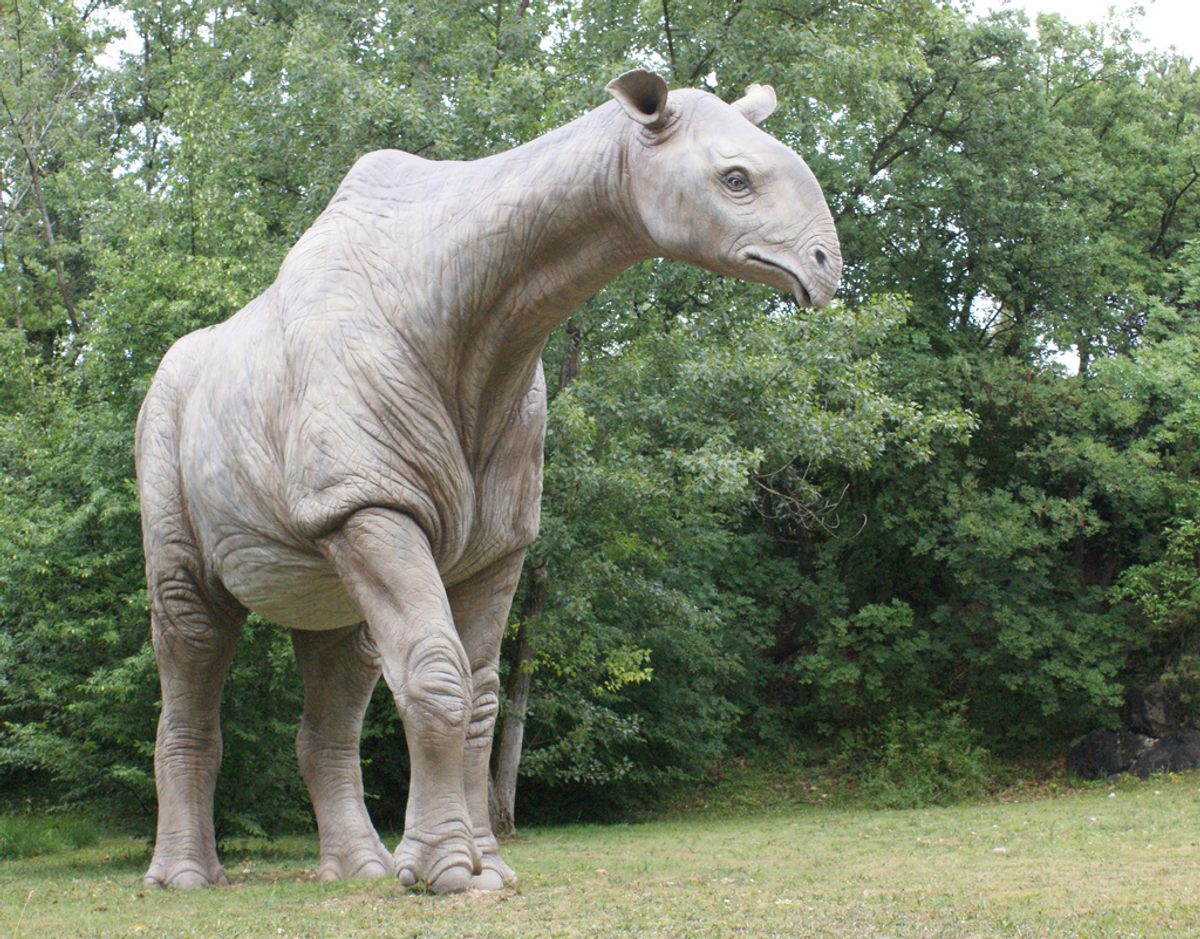
These are the things we know for sure: Paraceratherium was an early rhinoceros, at a time when there were many. It was large, even enormous. It had four legs and one head, bore live young, and ate plants. But trying to create a more detailed picture of this long-extinct animal means venturing into contentious territory. Paraceratherium was big, certainly, but how big—the size of five modern rhinos, or 15? Was it gracile and equine, or built like a stonking, herbivorous tank? Did it have the stubby ears of modern-day rhinoceroses or an elephant’s billowing lugs? Paleontologists do have answers to these questions, but they don’t always agree with one another on exactly what they are.

When it comes to dinosaurs, says the paleoartist and paleontologist Mark Witton, scientists are fascinated by proportions and “life appearance” and will regularly critique one another’s reconstructions. But the same doesn’t always apply for prehistoric mammals. “You get away from dinosaurs and there’s just not the same zeal for understanding what these things looked like,” he says. “People just haven’t done that work for Paraceratherium—so there’s about six different competing hypotheses about what this thing looks like.”
Precisely why these questions remain so contentious is complicated and multifaceted, involving detailed scientific arguments, office politics, and national identity. Paleontologists have studied this animal for over a century, yet questions still permeate, for reasons nearly as complicated as the puzzle of reconstructing an entire extinct rhino from a few bones.
In 1922, the American Museum of Natural History sponsored the naturalist Roy Chapman Andrews to make the first of a few grand, fossil-hunting tours of China and Mongolia. Andrews was a swashbuckling, Wisconsin-born explorer, who got his start at the museum as a janitor in the taxidermy department. He then travelled the world as a naturalist, hunting for beasts both recently and anciently deceased. (He may or may not have been the inspiration for Indiana Jones.) This trip, writes the paleontologist and author Don Prothero, was the “biggest scientific expedition ever to leave the United States.” Andrews, fellow fossil-hunting veteran Walter Granger, and their team hit the road with 75 camels, three cars, and two trucks, determined to find some of the most important fossils the world had ever seen.
That determination paid off. The trip reaped “a litany of important finds,” writes the science reporter Joseph Wallace in A Gathering of Wonders: Behind the Scenes at The American Museum of Natural History. These included “the theropod dinosaurs Velociraptor and Saurornithoides; the bizarre, beaked Oviraptor; the early horned dinosaur Protoceratops; armored Pinacosaurus, and others.” They found the fossils of mammals small and large, and “dozens of dinosaur eggs, many neatly arranged in nests.” But the first great find, and “the one that proved that the Gobi was more than a bowl of sand,” was Paraceratherium, which the museum’s president would later dub Baluchitherium grangeri, after Granger. “It was fossil hunting de luxe,” Andrews wrote in his diary on the day of the discovery, “and we laughed & sang for our hearts were light.”

At the time, America was experiencing a kind of paleontology madness for all things prehistoric. Andrews’s many expeditions were breathlessly chronicled in the New York Times, with one 1922 headline promising a story in which: “Cameras Amazed Natives; Motor Outran a Wild Ass; Sandstorm Brought Peril; Priceless Bones Found.”
There are a few reasons for this American enthusiasm, says the historian Chris Manias, and why more money was being funneled into paleontology in the United States than anywhere else in the world. Americans didn’t have the galleries, monuments, and architectural heritage of the Old World, and seem to have suffered a kind of inferiority complex as a result. Instead, Manias says, they turned to nature, and to the glory of the American environment, with its “greater wonders and more impressive things than in the Old World,” to make their mark on the world stage. National parks were created; American nature was celebrated. In turn, American scientists began to take an interest in paleontology.
With more funds, Manias says, American paleontologists could unearth “very, very impressive dinosaurs”—far more impressive than the shrimpy specimens found by their European colleagues. “It became this science where Americans were really making a contribution and an impact, over and above what’s being done in Europe.” And it didn’t matter that these dinosaurs were being found far away from American soil. “In terms of their pronouncements, they do actually literally say, ‘Right, we’re taking the Stars and Stripes to Mongolia and taking that material back,’” Manias explains. These were American discoveries abroad, to be brought home and celebrated by fellow patriots.

Where American explorers weren’t the first to uncover a species, their discoveries were often the most impressive. British and Russian geologists and paleontologists had been finding scatterings of Paraceratherium bones across Kazakhstan and Pakistan for more than 50 years before Andrews and his team arrived. But their discoveries were often poorly preserved, badly excavated, and incomplete.
The upshot? No one was quite sure what the bits they had found were, or how they fit into the landscape of earlier discoveries. A slew of names, and presumed species, ensued—Aceratherium; Paraceratherium; Indricotherium; Baluchitherium; Dzungariotherium. These days, paleontologists mostly agree that all of these mammals should share one name—Paraceratherium—though both Indricotherium and Baluchitherium are still used with confusing regularity, and there are many who contest that Dzungariotherium, whose teeth were first found in China in the 1970s, is an altogether separate genus.

In 1923, the American Museum of Natural History’s president, Henry Fairfield Osborn, attempted the museum’s first reconstruction of Paraceratherium. On their travels through Mongolia, Granger and Andrews had recouped a huge, near-complete skull, with molars the size of a human fist, and leg bones “like the trunk of a fossil tree,” Andrews wrote in The New Conquest of Central Asia. But that was all they had: The rest of the body had been weathered away over tens of millions of years, “and now lay scatted on the valley floor in a thousand useless fragments.”
From these broken bits, Osborn assembled a recognizably rhinoceroid rhino: large, stumpy and heavyset, with a hump on its back and a bloated behind. Later that year, as more fossil material became available, he revised it: The caboose remained the same, but the front end now had the long neck and pouting lips of a present-day camel.
As paleontologists acquired still more material, the reconstructions required refinement—so, in the mid-1930s, Granger and fellow paleontologist W. K. Gregory produced two more. By this point, it was near-certain that Paraceratherium and Baluchitherium were one and the same, yet the AMNH continued to refer to it as they had in extensive publicity following Andrews’ return: Baluchitherium, or the Beast of Balochistan. “From what we know of the politics at the American Museum in the 1930s,” Prothero notes, in his book, “their boss, Henry Fairfield Osborn … would probably not have been happy to see a genus he’d discussed frequently and heavily publicized disappear into synonymy.”
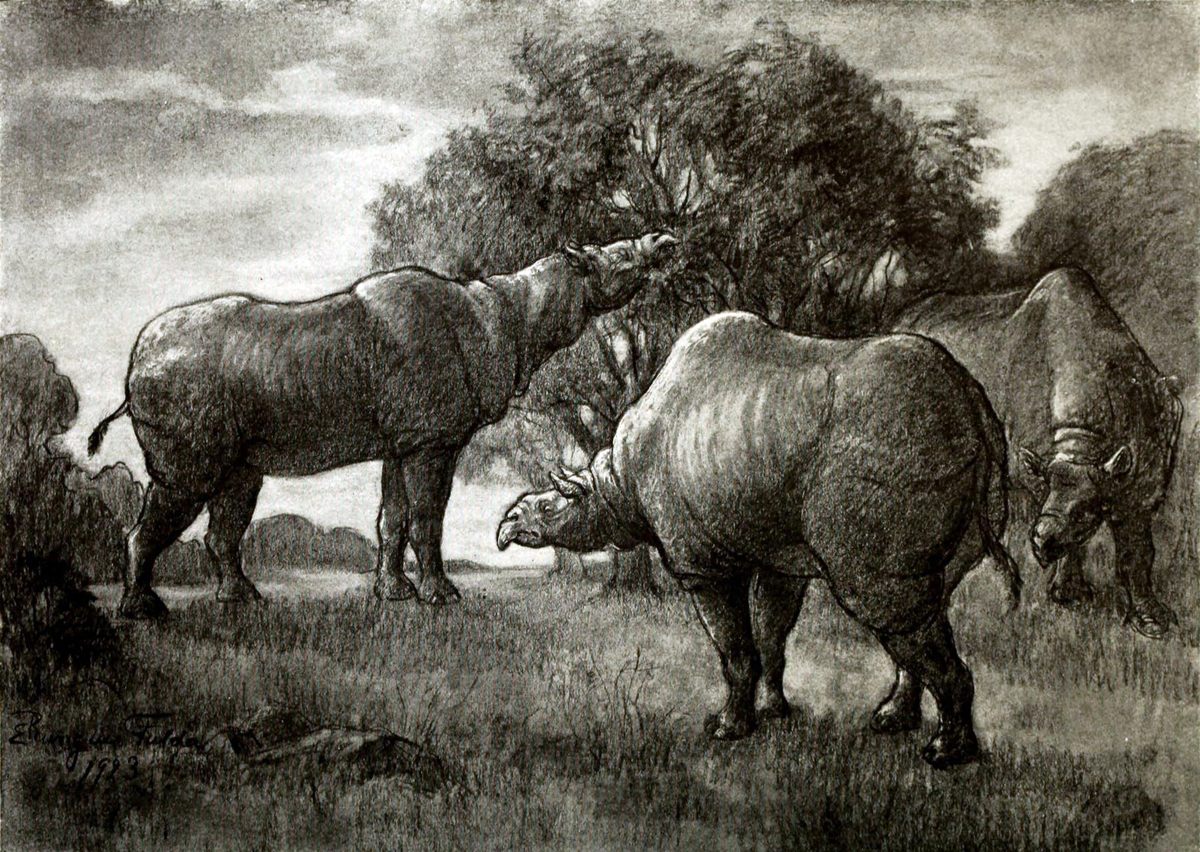
Granger and Gregory’s Beast, drawn by the museum’s department artist, Helen Ziska, was somewhere between Osborn’s two iterations. It had the same chunky torso, but on longer, more powerful legs, more suited to running across a domain likely up to 400 square miles in size. Unlike Osborn’s second drawing, its neck was thick and unwieldy. These drawings have often been cited as the starting point to estimate the mammal’s mass and size, with some scientists suggesting it may have weighed as much as 34 tons, and been over 25 feet from nose to tail.
There are many problems with this appealingly monstrous mammal. With only six neck bones at their disposal, and no particular knowledge of the structure of the ribs, Granger and Gregory based their ribs off the modern-day Indian rhino, and then scaled them up to fit. In fact, this technique seems to have filtered out to their approach more generally: Faced with a dearth of complete skeletons, Granger and Gregory took different-sized Paraceratherium bones from collections around the world and then scaled them up to fit their design.
Nowadays, it seems unlikely that Paraceratherium could have been as large as Granger and Gregory hoped. “It’s a very peculiar monster,” says the paleontologist Mikael Fortelius, who published an influential paper debunking the reconstruction in 1993, in which he decried this reconstruction as “a highly speculative creation indeed,” and claimed the animal was probably around half the mass originally thought. Most scientific evidence seems to suggest that there’s a maximum size of about 20 tons that mammals can reach before they collapse under their own weight, Fortelius says. But it’s not clear why the same doesn’t apply to dinosaurs, the largest of which weighed as much as 70 tons, suggesting that their skeletons may have been subtly, but crucially, different to our own mammalian bones.
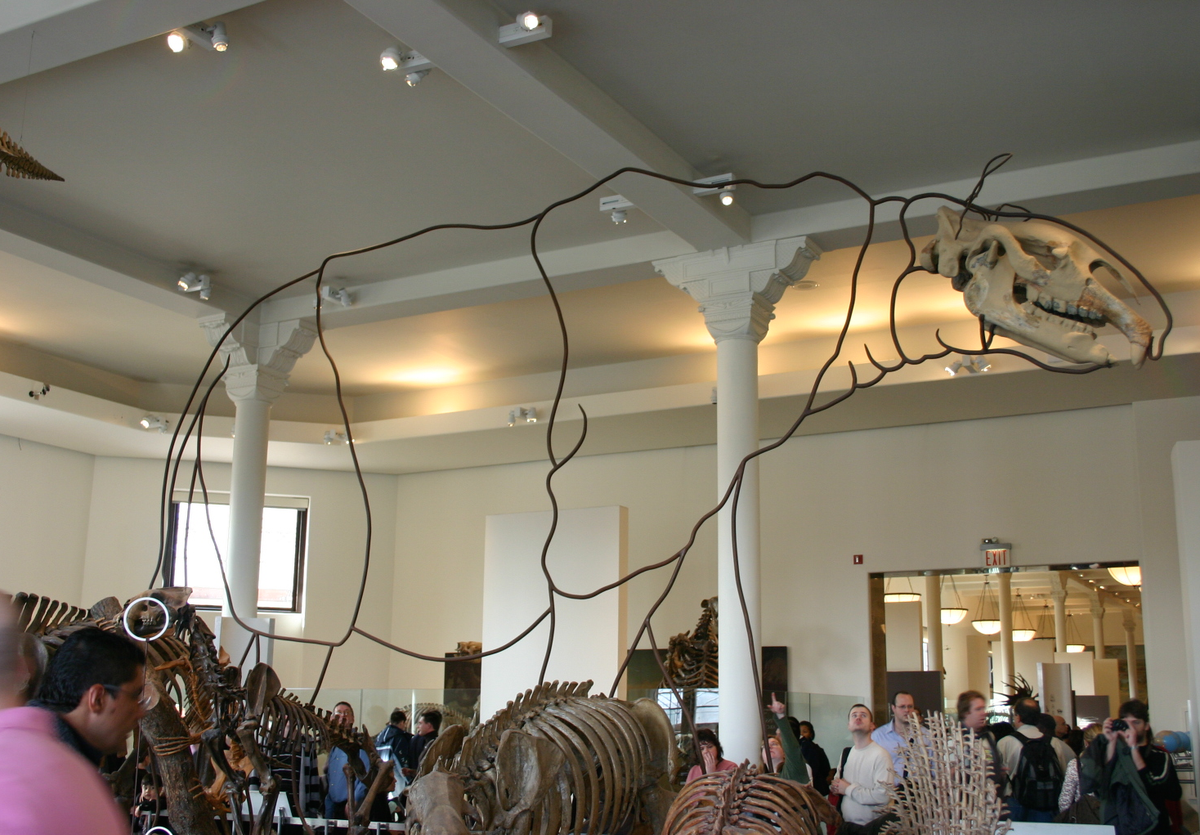
There are other downsides to being exceptionally large. Very big mammals, like elephants, have an achingly long gestational time—breeding, when it happens, is slow and high-risk. On top of that, Fortelius says, “mammals get into trouble when they are large because they can’t cool down very easily and they generate a lot of heat from fermentation of food in the stomach.” The sheer scale of dinosaurs beggars belief for that reason too, though Fortelius wonders whether they staved off overheating with “bird-like lungs, with a much more efficient flow of air, for example, and maybe they had other tricks as well that we don’t know about.”
Of course, little of this would have been known to these early paleontologists. Without soft tissue or even a complete skeleton, guessing the animal’s mass and makeup was a well-intentioned stab in the dark. It’s not surprising that so many of the reconstructions that emerged over the following century are quite different, says Manias. “The way that you put the creature together can be very, very different depending on your basic assumptions of what this thing is”—and whether that thing most resembled a giraffe, horse, rhinoceros, or okapi.
But there may have been other factors that contributed to the series of supersized monsters that trotted out of the AMNH. “In the early reconstructions, and particularly the ones which are coming out of New York, there is very much a desire to make sure that this is the largest land mammal that ever lived,” says Manias. The expeditions were, after all, “about aiming to get the most dramatic and the most exciting specimens,” with funding often tied to equivalently sensational discoveries. “Making sure that this is the largest thing ever is really, really significant for their research and for their entire fundraising activities.”
In the decades since, around half a dozen different designs for Paraceratherium have emerged from the paleontological woodwork. Some are slender and languid, and resemble horses. Others, like the 1959 reconstruction by the Soviet paleontologist Vera Gromova, have a long neck almost like a brontosaurus. These days, most paleontologists seem relatively comfortable with the idea that Paraceratherium was much smaller than original iterations of the early 20th century, with a long neck and powerful legs. It was large, certainly, and may have averaged between 10 and 15 tons, but a far cry from the 60,000 pounds that Osborn, Granger, and Gregory had in mind all those years ago.
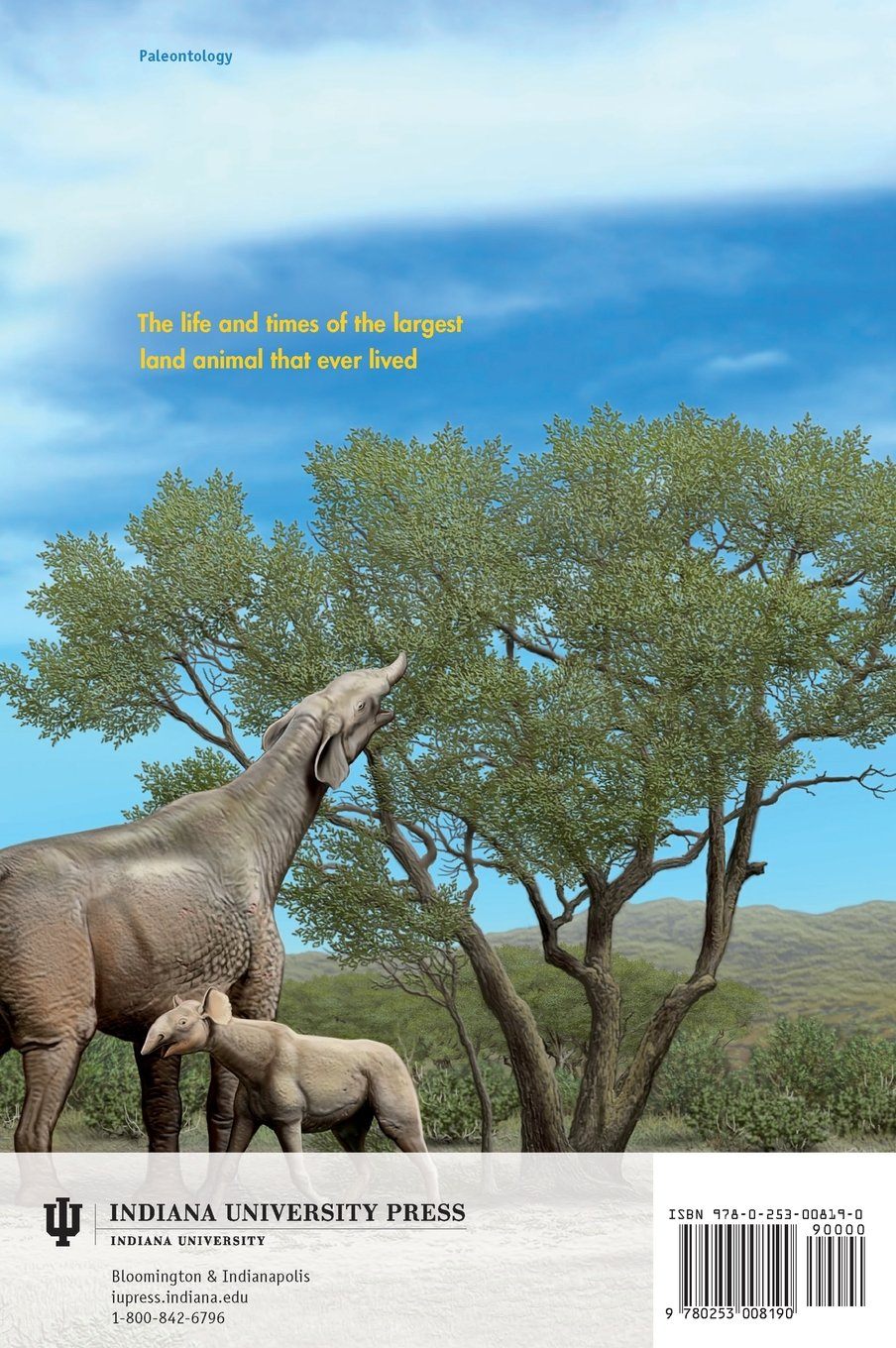
By the 2000s, the world had become accustomed to a fairly standard depiction of Paraceratherium (big boned, short-lipped, small-eared) immortalized in the BBC miniseries Walking With Beasts. But in 2013, the paleontologist Don Prothero published the book Rhinoceros Giants: The Paleobiology of Indricotheres with a striking illustration on the cover. This animal had a familiarly sinuous neck, with a torso and legs to match—but its head was entirely different. Instead of the camel-like head, Prothero posited, Paraceratherium’s face was more like an elephant, with lips that flared into a short trunk and big ears that were frilled like a scallop shell.
At a first glance, Prothero’s reasoning for the ears seems sound: Big mammals get hot, big ears help big mammals cool down. That, at least, is why elephants have them. But as a paleoartist also trying to figure out what Paraceratherium might have looked like, Mark Witton isn’t convinced that elephants are the best model for paleontologists. “The punchline there is, is that elephants are actually really terrible at keeping cool,” he says. “Their thermoregulation really stinks.” If you’re going to take any living animal as your exemplar, he says, rhinos are are a more obvious bet—and they simply haven’t developed ears of that size. “I think that’s that’s quite telling.”
But he is more accepting of the idea that Paraceratherium may have had a short trunk, or a long proboscis, like a tapir’s. Even when the soft tissue is long since perished, you can often tell when an animal has had a trunk or a proboscis by the shape of its skull, Witton says—how the bones above the nasal incision are shaped, for instance, or how far back into the skull it goes. “What we see in the big skulls of Paraceratherium is a lot more like that of a tapir than it is, say, like an elephant,” he says. With its big feet planted firmly on the ground, this enormous, hornless rhinoceros may have used its proboscis almost like hands, holding the branches of long-extinct trees still as it stripped the leaves off with its teeth. But plausible as it seems, Witton wrote in a blog post, it remains to be seen whether these proboscis will catch on in future reconstructions: “The reality of giant indricotheres [another term for Paraceratherium] with dangly noses may seem hard to swallow for those of us used to shorter lipped versions.”
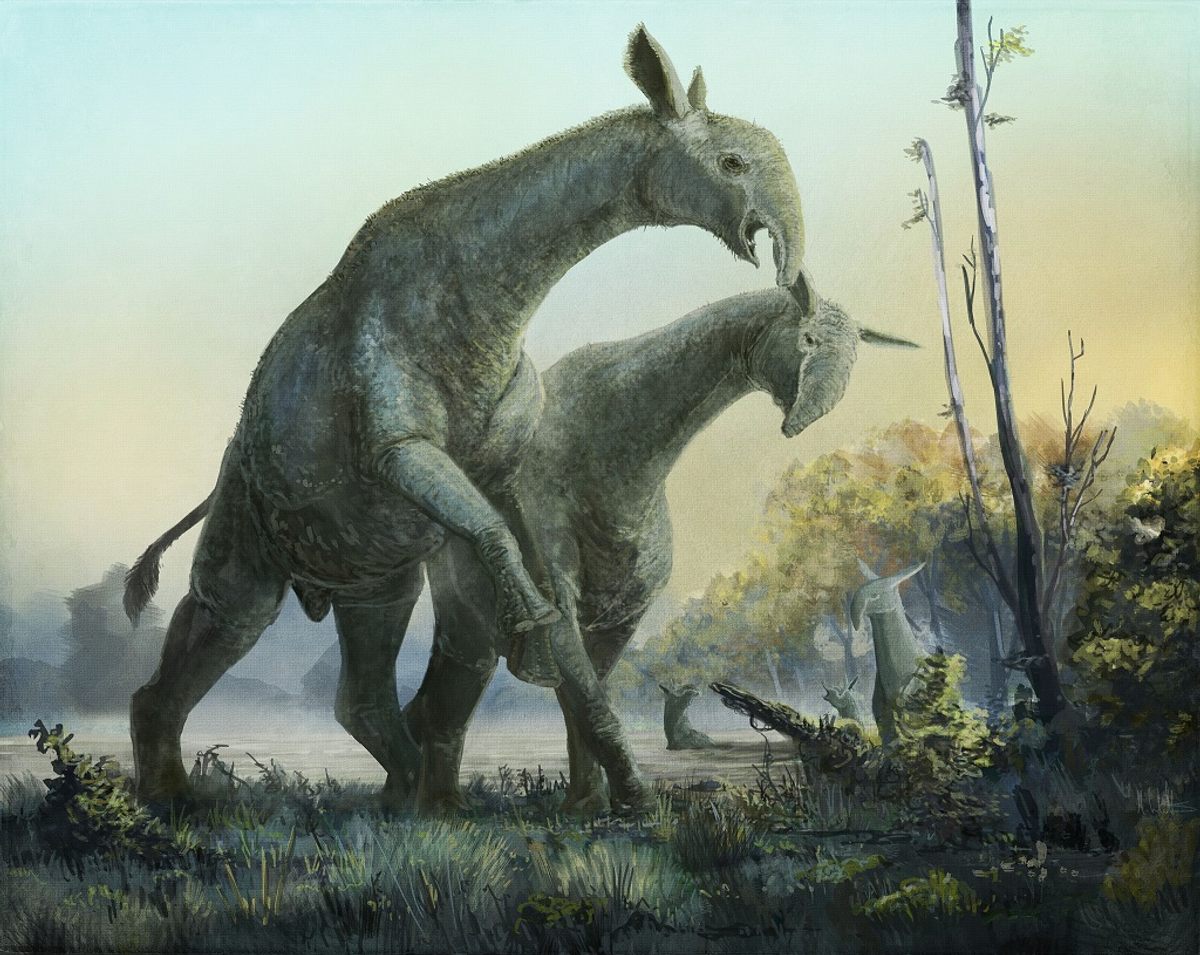
Witton’s own reconstruction, from 2016, does incorporate this dangly nose. His creature is lean and muscular, with pointed ears and a long, tapering proboscis. But even with the wealth of information we now have about Paraceratherium, how much it could have weighed, and what it might have looked like, he says, it’s still quite hypothetical: “In science, it’s acceptable to say, ‘We don’t know, this is a grey area.’ But as an artist, if you’re commissioned to reconstruct something, you can’t leave anything out. You can’t leave a question mark where the neck is. You’ve just got to do your best.” Two years on, he says, it’s a little out of date, and there may be other reconstructions around that take into account more recent work on the animal.
But the puzzle remains a challenging one. The animals are huge and the fossils are fragmentary. “You’re talking about building composite skeletons,” he says, where bits of one animal are applied to bits from another specimen. You might marry half the front of one animal to the back end of another, for instance, and scale them according to the upper limb bones. “But then you’ve got things like the neck, and how long was the neck and how big is the skull compared to the rest of it. It all starts to get quite complicated, really,” Witton adds. And for non-paleontologist artists, a wealth of misinformation around the animal does little to help researchers. To this day, the AMNH’s enormous exhibit uses the 1935 reconstruction many have decried as impossible. (The AMNH, when asked for comment, said they had a more up-to-date model of the animal, most recently exhibited in 2009.) And much of the most important scholarship is still locked away in hard-to-access journals.
Witton would like to see a rounded analysis of the reconstructions that have come before, and perhaps even an attempt at a definitive Paraceratherium. “This is a pretty popular fossil, mammal,” he says. “Lots of people are interested in this thing, it gets a lot of publicity, when people are talking about the extinct mammals, because it’s the biggest land mammal we’ve ever had.” And while museum exhibits may be expensive to alter, he says, “it’s not difficult to change things on paper. But for Indricotherium, that just hasn’t happened.” Until it does, many conflicting Paraceratheriums, with as many different names, faces and shapes, continue to coexist, stomping around in the hypothetical Oligocene landscape.
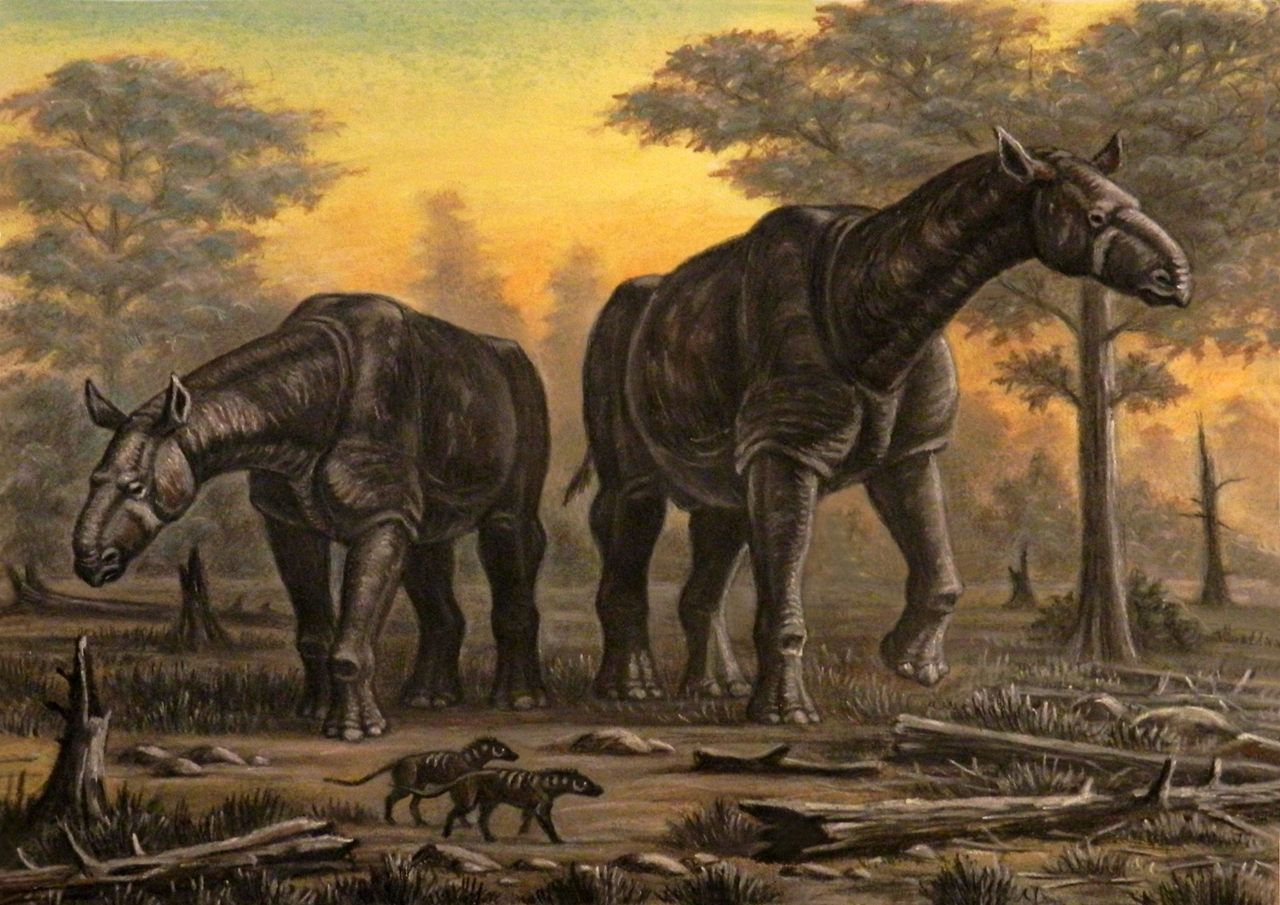


















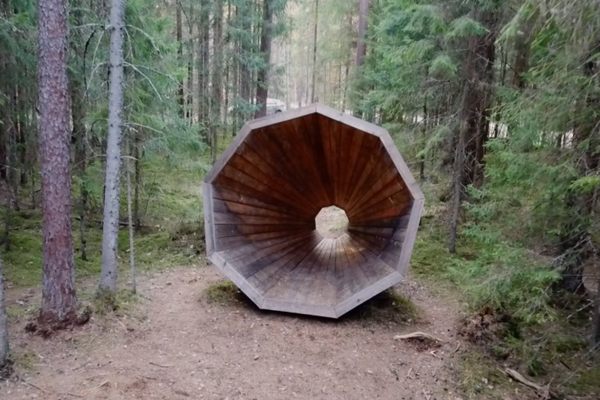


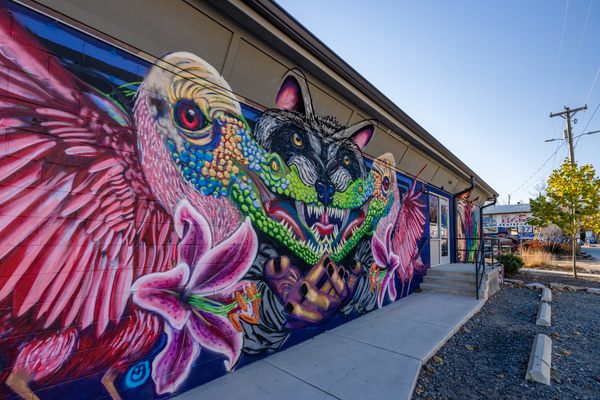




Follow us on Twitter to get the latest on the world's hidden wonders.
Like us on Facebook to get the latest on the world's hidden wonders.
Follow us on Twitter Like us on Facebook